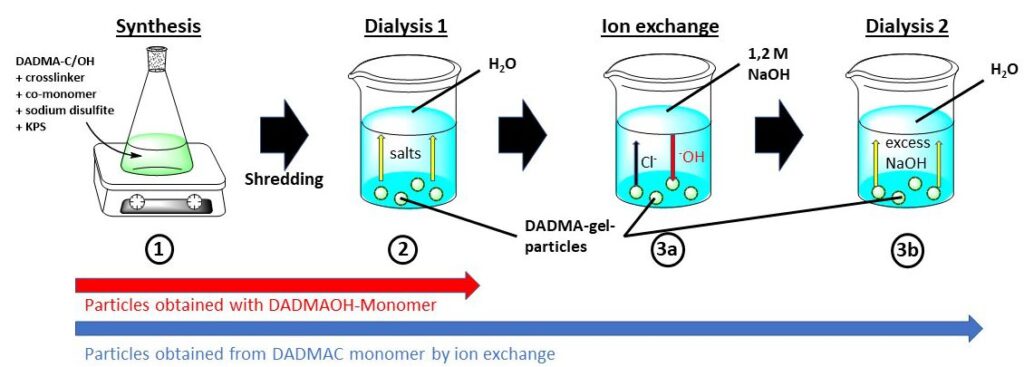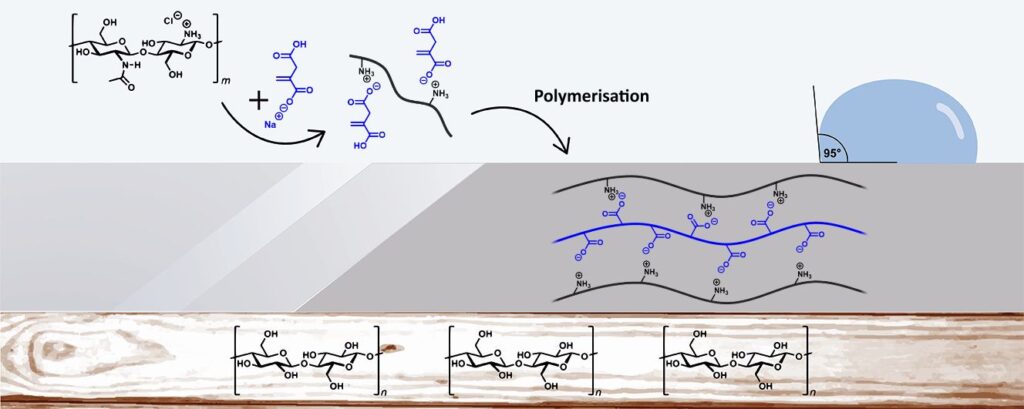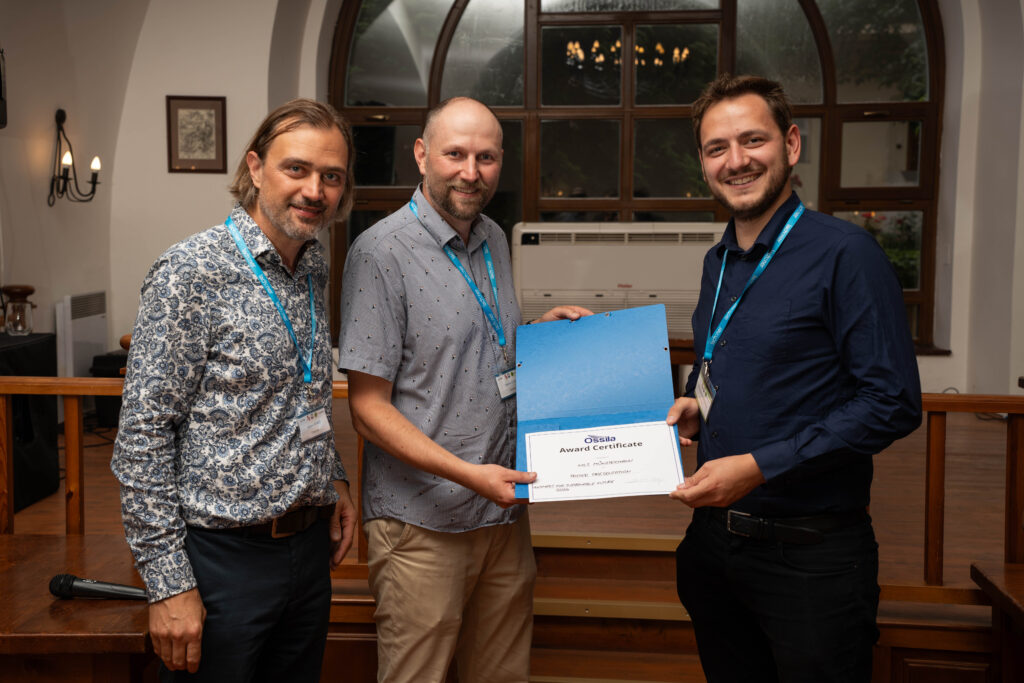New publication: Fire-retardant wood coating

Wood is currently experiencing a renaissance in the construction and furniture industry. With its natural charm, versatility and environmental friendliness, wood is a popular building material. However, this natural material is susceptible to external influences such as moisture, UV radiation, stains and, above all, fire. Fire in particular poses a major risk in the construction industry due to the easy flammability of wood. Once ignited, untreated wood often burns down completely without any external heat supply. N. Münstermann and O. Weichold have now developed an innovative, sustainable wood coating based on polymerized chitosanitaconate. The basis of the coating, chitosan, is a residual product from the food industry and itaconic acid can be obtained biotechnologically. The coating is therefore made entirely from bio-based materials and not only offers protection against moisture, UV radiation and stains, but is also non-flammable. When applied to wood, it delays ignition and significantly inhibits the spread of flames. Just one coat reduces the burning rate by a third. Two coats on spruce wood are enough to make the material self-extinguishing. Three layers are required for hardwoods such as beech. This bio-based approach combines resource conservation with high effectiveness and shows that environmental protection and safety requirements can go hand in hand.
N. Münstermann, O. Weichold
A fire-retardant coating for wood made from chitosan itaconate
Progress in Organic Coatings 2024, 197, 108793 https://doi.org/10.1016/j.porgcoat.2024.108793
63rd “Aachener Baustofftag”
Prof. Weichold gave a lecture entitled “Cross-linked, highly alkaline hydrogels in maintenance” at the 63rd “Aachener Baustofftag” and BÜV advanced training for expert planners on November 14 and 15, 2024 in Aachen.
New publication:Approaches to upscaling alkaline gels as particles

Highly alkaline hydrogels are becoming increasingly important in building materials research. We have been able to show repeatedly that cationic alkaline hydrogels based on diallyldimethylammonium hydroxide (DADMAOH) in particular can be used effectively to seal water-bearing cracks or as coupling media for electrochemical chloride extraction. Upscaling is a challenge, as commercial cation-selective membranes have proven to be less effective here. On the other hand, neutral gels and gel particles can be easily prepared from diallyldimethylammonium chloride (DADMAC) in large quantities and with a wide range of compositions. Here it is shown that these neutral gel particles can be converted into DADMAOH particles with residual halide contents of <0.3 % by means of inverse static anion exchange in NaOH solution. The physical and chemical properties of the alkaline particles correspond to those of the alkaline gels and fulfill all necessary requirements for building material applications, but are much easier to produce.
T. B. Mrohs, O.Weichold
A Simple Preparation of Crosslinked, Highly Alkaline Diallyldimethylammonium Hydroxide Hydrogel Particles via Inverse Static Anion Exchange
Gels 2024, 10, 743. https://doi.org/10.3390/gels10110743 (open access)
17th ICPIC conference papers reprinted
The articles on the presentations “Ionic Conductive Polyesters-Assessing the Risk of Corrosion in Steel-Reinforced Concrete” by Prof. Weichold and “Alkaline Hydrogels-Multifunctional Materials for Concrete Rehabilitation” by Tim Mrohs (see also entry from 19.9.2023) at the 17th International Congress on Polymer in Concrete (ICPIC 2023) in Warsaw, Poland, have now been published in print.
Weichold, O. (2025). Ionic Conductive Polyesters—Assessing the Risk of Corrosion in Steel-Reinforced Concrete. In: Czarnecki, L., Garbacz, A., Wang, R., Frigione, M., Aguiar, J.B. (eds) Concrete-Polymer Composites in Circular Economy. ICPIC 2023. Springer Proceedings in Materials, vol 61. Springer, Cham. https://doi.org/10.1007/978-3-031-72955-3_34
Mrohs, T., Jung, A., Weichold, O. (2025). Alkaline Hydrogels—Multifunctional Materials for Concrete Rehabilitation. In: Czarnecki, L., Garbacz, A., Wang, R., Frigione, M., Aguiar, J.B. (eds) Concrete-Polymer Composites in Circular Economy. ICPIC 2023. Springer Proceedings in Materials, vol 61. Springer, Cham. https://doi.org/10.1007/978-3-031-72955-3_37
6th Junior EPNOE
At the 6th European Polysaccharide Network of Excellence (EPNOE) Junior Scientist Meeting 2024, September 4-6, 2024 in Vienna, Austria, we were represented with two contributions:
Nils Münstermann
High-Strength Chitosan-bonded Fibreboards in Sustainable Construction (presentation)
Paul Marten
Development of a Chitosan-Based Adhesive for Wood-Acrylic Glass Laminates (short presentation and poster)
New publication: Wood coating made from biogenic residues

Wood has been a central building material for mankind for thousands of years and is characterised by its bioavailability, sustainability and versatility. Nevertheless, the chemical structure of wood poses a number of challenges. It is susceptible to biological degradation processes, for example by fungi, bacteria or insects, and shows signs of graying due to lignin degradation when exposed to UV radiation. To prevent this, N. Münstermann and O. Weichold have developed an environmentally friendly coating based on chitosan, a biopolymer obtained from food waste.
The newly developed chitosanitaconate coating is transparent, emphasizes the wood grain and gives the wood hydrophobic properties with contact angles of over 90°. It effectively protects the wood from moisture, prevents graying caused by UV radiation and reduces staining caused by coffee or red wine, for example. Thanks to its strong adhesion and adaptability, the coating is highly versatile. By adding pigments, the coating can be adapted to the aesthetic requirements of modern interior design. Chitosanitaconate combines wood protection, modern aesthetics and sustainability – a versatile solution for environmentally friendly construction.
N. Münstermann, O. Weichold
Chitosan itaconate based water- and stain-repellent coatings for wood
Progress in Organic Coatings 2024, 194, 108630 https://doi.org/10.1016/j.porgcoat.2024.108630
Presentation
Nils Münstermann gave a presentation entitled ‘Chitosan as an environmentally friendly binder for high-strength fibreboards’ at the 2024 doctoral seminar of the GDCh Construction Chemistry Division in Aachen, Germany.
Presentation
Paul Marten gave a presentation entitled ‘Development of a chitosan-based adhesive for wood-acrylic glass bonding’ at the 2024 doctoral seminar of the GDCh Construction Chemistry Division in Aachen, Germany.
New PhD Student
We have welcomed Lena Schmitz to the bio-based building materials department in July. In her dissertation, she is investigating the properties and potential applications of the fibre protein keratin, which is obtained from sheep’s wool, feathers, hair and hooves, among other things. She is trying to recycle these waste products sensibly and research environmentally friendly, resource-saving and sustainable materials for the construction industry. We wish her every success with her research and welcome her to the working group.
Nils Münstermann earns an Award

Nils Münstermann receives the poster prize at the Polymers for Sustainable Future 2024 conference in Prague for his contribution ‘Chitosan-Based Coatings for the Water-Proofing of Wood’.



